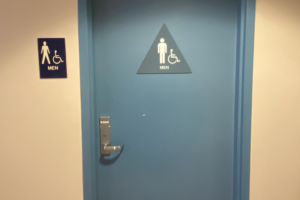For some, walking into the quarantined housing on campus may feel more like a prison sentence than an isolated dorm quarantine. In light of the recent pandemic, Point Loma Nazarene University has established “isolation halls” across campus for students who test positive for COVID-19, but didn’t have a place to stay in the area. Although recent improvements have been made, students have opened up about why their on-campus quarantine experience was harmful both to their physical and mental health.
“It didn’t seem like it was going to be too fun. I felt like I was going into a prison cell,” junior Hayley Kline said when she first walked into the isolated housing. Sectioned off from other students, designated quarantined hallways or pods are scattered across multiple dorms on campus. For Kline, it was Goodwin.
After receiving a positive test, a student with COVID-19 has a short period of time to move a week’s worth of belongings into one of these designated areas. Unless there are other positive cases on campus, students will live in the hallway or pod alone until they are cleared to leave.
Vice president of spiritual life and formation Mary Paul comments on the school’s overall success in maintaining COVID-19 case numbers. There are currently only five active positive cases in the school with one of those cases in residential quarantine.
“With no surge, we have been able to walk this out really successfully,” Paul explained.
Everyone plays a role in forming a consistent model for dealing with COVID-19 cases, said Paul. While the numbers look good, she does acknowledge how messy the whole situation is.
Cafeteria food is delivered to students via a knock on the door. Once they hear the knock, students are free to open the door and pick up their meals. While this delivery method is the only way to avoid contact, it contributes an impersonal element to the whole experience.
“I felt like they were doing the best they could with the no contact thing,” said freshman Teanajae Kua’ana. “It didn’t feel great to pick up the food outside of the door. People would see us poke our head out as if we were sneakily trying to get it. It didn’t add well to the whole mental emotional part of it.”
For Kua’ana, moving into isolated housing was not something she envisioned for her first week of college. In addition to the added stress of leaving home for the first time, she missed out on the new student orientation activities.
In a way, Kua’ana and her group of quarantined associates pioneered the path for new improvements to isolated housing. “They didn’t even think about letting people outside at first,” said Kua’ana. “I think we had to beg them to let us go on a walk.” As a result of this communication, students are now able to go to McCullough Park or the Alumni Lawn from 3 pm to 5 pm for a change of scenery.
“That was the saving grace, being able to have fresh air,” said Kline. A few hours outside of familiar walls can really do wonders for a person’s mental health. As an additional improvement, a website for spiritual care is made available to all students in isolation housing in order to help them check in on their spiritual and mental health.
Students also reported the toll that COVID-19 took on their physical health. For a sophomore, who was quarantined during a large wave of positive tests last year and wished to remain anonymous, her fatigue made her pass out.
“They ended up calling 911 because I hit my head. Since it was a COVID-19 hall, they made me walk outside because they didn’t want to come in,” said the sophomore.
The most common COVID-19 symptoms for these students were fatigue, loss of taste, body aches and, in one case, passing out. As a general consensus, students would have appreciated it if the Wellness Center followed through on the daily symptom calls.
“To know that someone is checking on you can make a huge difference,” said Kline.
While the circumstances make it very difficult for major improvements, students noted a few changes that would help the overall atmosphere of isolated housing. Both Kline and Kua’ana mentioned how beneficial it would be to have a designated outdoor area accessible at all times. The sophomore said that plenty of water and Gatorade should be provided, with the chance to choose a meal choice from the cafeteria, instead of getting a random selection.
In light of these suggestions, Paul notes the added challenge in oversight to make sure students always practice isolation. One of the biggest contributors to improvement is based on what staffing is available.
Paul said, “Finding what we can do and what we have the staffing to oversee,” plays a large role in additional improvement.
Paul said it is important to acknowledge that isolation is a difficult challenge no matter the situation, so students should keep voicing their concerns. “There’s no taking away the stress of it. There’s no way to make isolation a happy experience,” Paul said.
These students’ perspectives provide a look into the way that PLNU is dealing with COVID-19 cases. Regardless of where or how a person is isolated, seclusion can take a toll on a person’s mental and physical health.
“I tried to block out that I was in there for the first couple of days,” said Kua’ana. “Around the third or fourth day, with seeing the same four walls, it was starting to get a little depressing.”
By: Sofie Fransen








